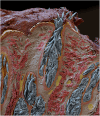Reducing ocular Demodex using petroleum jelly may alleviate dry eye syndrome, blepharitis, facial dermatoses, ocular and respiratory allergies, and decrease associated prescribing: a hypothesis
- PMID: 40909167
- PMCID: PMC12405285
- DOI: 10.3389/falgy.2025.1576102
Reducing ocular Demodex using petroleum jelly may alleviate dry eye syndrome, blepharitis, facial dermatoses, ocular and respiratory allergies, and decrease associated prescribing: a hypothesis
Abstract
Demodex eyelash mites are increasingly associated with eye and skin inflammation in humans, and cause demodectic mange in mammals. Informal accounts of symptom improvement and reduced need for anti-allergy medicines, when Demodex reproduction is prevented, indicate a further role linking Demodex to rhinitis, asthma and dermatitis. Their mobility, allergenic debris and consequential immunological impact may also explain progression of allergies in the "allergic march". Being photophobic and nocturnal, Demodex folliculorum shelter, feed, and sleep in eyelash follicles during daylight. Coston (1967) speculated that Demodex emerge to mate during darkness and observed that medicated ointments rubbed into the eyelid margins at bedtime treated Demodex blepharitis effectively, presumably by preventing mating. Sixteen cases are described retrospectively whereby interested volunteers adopted Coston's technique, using unmedicated petroleum jelly. To break the lifecycle, a minimum 28-day course was advised, though concordance varied. Fourteen people reported relief from a surprising range of symptoms including not only dry eye and blepharitis but also rhinitis, asthma, angioedema and seborrhoeic dermatitis. Analysis of GP prescribing data in three volunteers allowed comparison of five-year periods immediately before and after starting continuous treatment. Mean yearly issues of anti-allergy and antimicrobial medicines reduced from 15.6 (range 8-25) to 1.8 (range 0-4), representing an 88.5% decrease for Volunteer 1 and from 5.8 (range 3-9) and 14.2 issues (range 9-24) to zero for both Volunteer 2 and Volunteer 13 respectively, representing 100% reductions in prescribing. Exacerbations of acne and dermatitis in two cases illustrate possible Demodex involvement in common dermatoses. This account is limited by its informal and retrospective nature in a disparate cohort, without assessment of Demodex levels. These preliminary observations support the hypothesis that Demodex allergens may trigger facial, ocular and respiratory inflammation and that reducing mite count with petroleum jelly improves symptoms. Formal clinical trials are needed to test this hypothesis.
Keywords: Demodex; allergy; asthma; blepharitis; dermatitis; petroleum jelly; prescribing; rhinitis.
© 2025 Senior-Fletcher.
Conflict of interest statement
The author declares that the research was conducted in the absence of any commercial or financial relationships that could be construed as a potential conflict of interest. Trademarks have been registered for The Demodex Project® and for Parasplat®, because a bespoke product with full instructions for application would simplify patient consultations, prescribing and ‘over the counter’ sales. This would be marketed in a not-for-profit or charitable context with the hope of raising funds for future Demodex research.
Figures




References
-
- Platts-Mills TAE, Adkinson NF, Bochner BS, Busse WW, Holgate ST, Lemanske R, et al. Middleton’s Allergy Principles and Practice. 7th edn. Philadelphia: Mosby Elsevier; (2009). p. 539–52.
LinkOut - more resources
Full Text Sources

